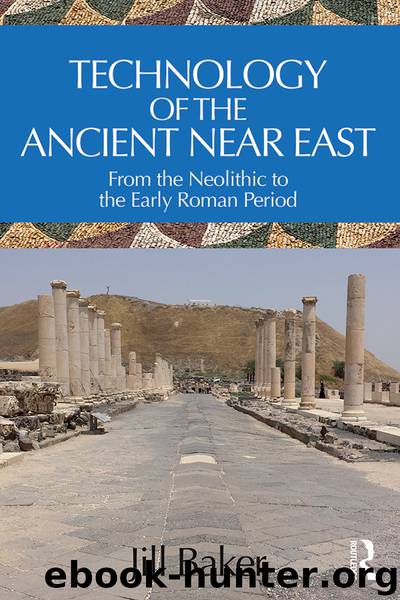Technology of the Ancient Near East by Jill Baker

Author:Jill Baker
Language: eng
Format: epub
Publisher: Taylor & Francis (CAM)
Most of the known medical papyri, such as the Edwin Smith Papyrus, were written during the Old Kingdom. The medical papyri as a corpus show the progression of medical practice beginning with the incorporation of magic in earlier writings to a decreased use of magic as a result of medical knowledge and greater trust in science. This suggests confidence in the achievements and abilities of medical science (Nunn 2002; Yamauchi and Wilson 2016 vol. III:256–259).
The earliest known physician is Imhotep (ca. 2650–2600), who was not only a physician but a priest, an architect, and an engineer. Imhotep, whose name means, “one who comes in peace, is with peace,” was an official serving Pharaoh Djoser and was the architect of the pyramid of Djoser at Saqqara, ca. 2630–2611 BCE. He was also the likely author of the Edwin Smith Papyrus, a medical treatise. This papyrus presents a rational approach to medicine but acknowledges that as a priest he could invoke magical healing when necessary. From this papyrus, it is clear he knew the medicinal uses of plants. Aside from Imhotep, several other physicians are known, mostly by the discovery of their tombs. Unless otherwise noted, these tombs were found at Saqqara:
Hesy-Ra (ca. 2670 BCE) practiced during the reign of Djoser, was Chief of Dentists and Physicians, and Chief of the King’s Scribes.
Merit-Ptah (ca. 2700 BCE), a female who was Chief Physician.
Penthu (ca. 1350 BCE), Chief Physician to Akhenaten, Amarna Tomb 5.
Peseshet (ca. 2500 BCE), Fourth Dynasty, Lady Overseer of the Female Physicians.
Iwti (ca. 2500 BCE), Nineteenth Dynasty, Chief Physician.
Qar (ca. 2350–2180 BCE), a royal physician in the Sixth Dynasty. His mummy was in a limestone sarcophagus with twenty-two bronze statues of different deities including a statue of Imhotep. Also included were the oldest bronze surgical tools discovered. He died at the age of 50.
Psamtikseneb (ca. 664–525 BCE), Twenty-sixth Dynasty, Head of Physicians, and a dentist. Tomb at Heliopolis.
Udjahorresenet Twenty-sixth Dynasty, Head of Physicians, supervisor of medical schools called Houses of Life. Tomb at Abu Sir.
Harsiese son of Ramose (ca. 550 BCE), Head of Physicians, Chief Physician of Upper and Lower Egypt, Leader of Aegean foreign troops and admiral of the royal fleet.
Petuaneith Twenty-sixth Dynasty, Chief Physician.
Shepseskaf-Ankh Old Kingdom, Fifth Dynasty, ca. 2465–2325 BCE. His tomb was located at Abu Sir, and he was Head of the Physicians of Upper and Lower Egypt. He was a priest of Ra in the Temple of the Sun, a priest of the god of Khnum, and a priest of magic.
Download
This site does not store any files on its server. We only index and link to content provided by other sites. Please contact the content providers to delete copyright contents if any and email us, we'll remove relevant links or contents immediately.
| Automotive | Engineering |
| Transportation |
Whiskies Galore by Ian Buxton(41712)
Introduction to Aircraft Design (Cambridge Aerospace Series) by John P. Fielding(33011)
Small Unmanned Fixed-wing Aircraft Design by Andrew J. Keane Andras Sobester James P. Scanlan & András Sóbester & James P. Scanlan(32678)
Craft Beer for the Homebrewer by Michael Agnew(18076)
Turbulence by E. J. Noyes(7888)
The Complete Stick Figure Physics Tutorials by Allen Sarah(7258)
Kaplan MCAT General Chemistry Review by Kaplan(6813)
The Thirst by Nesbo Jo(6748)
Bad Blood by John Carreyrou(6468)
Modelling of Convective Heat and Mass Transfer in Rotating Flows by Igor V. Shevchuk(6349)
Learning SQL by Alan Beaulieu(6152)
Weapons of Math Destruction by Cathy O'Neil(6077)
Man-made Catastrophes and Risk Information Concealment by Dmitry Chernov & Didier Sornette(5870)
Digital Minimalism by Cal Newport;(5576)
Life 3.0: Being Human in the Age of Artificial Intelligence by Tegmark Max(5397)
iGen by Jean M. Twenge(5295)
Secrets of Antigravity Propulsion: Tesla, UFOs, and Classified Aerospace Technology by Ph.D. Paul A. Laviolette(5232)
Design of Trajectory Optimization Approach for Space Maneuver Vehicle Skip Entry Problems by Runqi Chai & Al Savvaris & Antonios Tsourdos & Senchun Chai(4949)
Electronic Devices & Circuits by Jacob Millman & Christos C. Halkias(4859)
